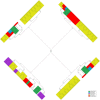Embodied cognitive morphogenesis as a route to intelligent systems
- PMID: 37065267
- PMCID: PMC10102728
- DOI: 10.1098/rsfs.2022.0067
Embodied cognitive morphogenesis as a route to intelligent systems
Abstract
The embryological view of development is that coordinated gene expression, cellular physics and migration provides the basis for phenotypic complexity. This stands in contrast with the prevailing view of embodied cognition, which claims that informational feedback between organisms and their environment is key to the emergence of intelligent behaviours. We aim to unite these two perspectives as embodied cognitive morphogenesis, in which morphogenetic symmetry breaking produces specialized organismal subsystems which serve as a substrate for the emergence of autonomous behaviours. As embodied cognitive morphogenesis produces fluctuating phenotypic asymmetry and the emergence of information processing subsystems, we observe three distinct properties: acquisition, generativity and transformation. Using a generic organismal agent, such properties are captured through models such as tensegrity networks, differentiation trees and embodied hypernetworks, providing a means to identify the context of various symmetry-breaking events in developmental time. Related concepts that help us define this phenotype further include concepts such as modularity, homeostasis and 4E (embodied, enactive, embedded and extended) cognition. We conclude by considering these autonomous developmental systems as a process called connectogenesis, connecting various parts of the emerged phenotype into an approach useful for the analysis of organisms and the design of bioinspired computational agents.
Keywords: 4E cognition; cognitive systems; developmental connectomics; embodied intelligence; morphogenesis.
© 2023 The Author(s).
Conflict of interest statement
We declare we have no competing interests.
Figures






Similar articles
-
How Radical Is Embodied Creativity? Implications of 4E Approaches for Creativity Research and Teaching.Front Psychol. 2019 Oct 22;10:2372. doi: 10.3389/fpsyg.2019.02372. eCollection 2019. Front Psychol. 2019. PMID: 31695653 Free PMC article.
-
Cognition as Morphological/Morphogenetic Embodied Computation In Vivo.Entropy (Basel). 2022 Oct 31;24(11):1576. doi: 10.3390/e24111576. Entropy (Basel). 2022. PMID: 36359666 Free PMC article.
-
How to build a better 4E cognition.Cogn Neurosci. 2024 Jul-Oct;15(3-4):104-105. doi: 10.1080/17588928.2024.2403340. Epub 2024 Sep 21. Cogn Neurosci. 2024. PMID: 39306677
-
The body of knowledge: On the role of the living body in grounding embodied cognition.Biosystems. 2016 Oct;148:4-11. doi: 10.1016/j.biosystems.2016.08.005. Epub 2016 Aug 16. Biosystems. 2016. PMID: 27543133 Review.
-
From Brain Models to Robotic Embodied Cognition: How Does Biological Plausibility Inform Neuromorphic Systems?Brain Sci. 2023 Sep 13;13(9):1316. doi: 10.3390/brainsci13091316. Brain Sci. 2023. PMID: 37759917 Free PMC article. Review.
References
Associated data
LinkOut - more resources
Full Text Sources
Research Materials

